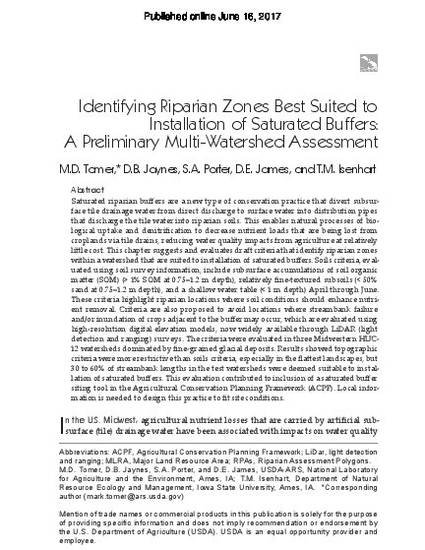
Saturated riparian buffers are a new type of conservation practice that divert subsurface tile drainage water from direct discharge to surface water into distribution pipes that discharge the tile water into riparian soils. This enables natural processes of biological uptake and denitrification to decrease nutrient loads that are being lost from croplands via tile drains, reducing water quality impacts from agriculture at relatively little cost. This chapter suggests and evaluates draft criteria that identify riparian zones within a watershed that are suited to installation of saturated buffers. Soils criteria, evaluated using soil survey information, include subsurface accumulations of soil organic matter (SOM) (> 1% SOM at 0.75–1.2 m depth), relatively fine-textured subsoils (< 50% sand at 0.75–1.2 m depth), and a shallow water table (< 1 m depth) April through June. These criteria highlight riparian locations where soil conditions should enhance nutrient removal. Criteria are also proposed to avoid locations where streambank failure and/or inundation of crops adjacent to the buffer may occur, which are evaluated using high-resolution digital elevation models, now widely available through LiDAR (light detection and ranging) surveys. The criteria were evaluated in three Midwestern HUC-12 watersheds dominated by fine-grained glacial deposits. Results showed topographic criteria were more restrictive than soils criteria, especially in the flattest landscapes, but 30 to 60% of streambank lengths in the test watersheds were deemed suitable to installation of saturated buffers. This evaluation contributed to inclusion of a saturated buffer siting tool in the Agricultural Conservation Planning Framework (ACPF). Local information is needed to design this practice to fit site conditions.
Available at: http://works.bepress.com/thomas_isenhart/59/

Tomer, M.D., D.B. Jaynes, S.A. Porter, D.E. James, T.M. Isenhart 2017. Identifying Riparian Zones Best Suited to Installation of Saturated Buffers: A Preliminary Multi-Watershed Assessment. In: J. Delgado, G. Sassenrath, T. Mueller, editors, Precision Conservation: Geospatial Techniques for Agricultural and Natural Resources Conservation, Agron. Monogr. 59. ASA and CSSA, Madison, WI. doi: 10.2134/agronmonogr59.2013.0018.